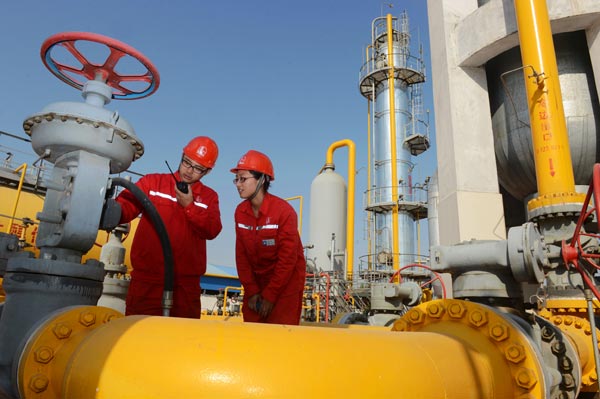 |
|
Sinopec workers inspect a natural gas facility in Puyang, Henan province. [Photo/China Daily] |
Arrival will have 'significant impact' on the global natural gas industry
A liquefied natural gas ship named Methane Rita Andrea carrying 60,000 metric tons of the clean fuel from Queensland, Australia will arrive at China's receiving terminal in Tianjin in around nine days-a shipment that is expected to help further improve the country's energy consumption structure.
The LNG is coming from the Curtis LNG project, China's first foreign LNG operation, which is owned by the country's largest LNG importer CNOOC Ltd.
The country's biggest offshore oil and gas company signed an agreement worth $1.93 billion last year to buy LNG from British gas producer BG Group, increasing its stake in BG's Queensland Curtis LNG project from 10 percent to 50 percent at the same time.
"The success of this first cargo shipment to China from the project in Australia will have a significant impact on the global natural gas industry," said Wang Yilin, chairman of CNOOC.
With CNOOC as the second-largest shareholder and investor in the Curtis project, it is the first time that China has participated in the full industrial chain of an LNG project.
Through the cooperation, CNOOC will receive a stable LNG supply of 8.6 million tons annually from QCLNG.
With China aiming to raise the share of clean energy within its total primary energy consumption mix, natural gas has become increasingly important.
On the one hand, the State-owned energy players are investing in conventional natural gas and unconventional resources including shale gas production to raise domestic output.
On the other, energy companies led by CNOOC are increasing their LNG imports to meet growing domestic demand.
Michael Stoppard, chief strategist of global gas with US-based consultancy IHS, told an industrial conference in Beijing earlier this month that the global LNG market currently has more supply than demand and that supply is set to grow significantly, starting from 2016.
He said the LNG spot market has also weakened in 2014, and that he expected real change over the next two years.
Qian Xingkun, vice-president of CNPC Economics and Technology Research Institute, said: "All the LNG suppliers are currently focusing on the China market."
He said Asia will have demand for 50 million metric tons of new LNG imports annually by 2020, and China will take a major part of that, with annual imports expected to grow about 10 percent.
Faced with this growing Chinese LNG demand, Qian called for the creation of an alliance of Asian LNG buyers, which could ensure better prices.
